Crepe Myrtle or Lagerstroemia indica plants are a fantastic floral choice when it comes to medium or large trees. These deciduous trees offer a gorgeous blooming canopy and are year-round garden performers.
Whether you’re growing for trees or shrubs, the crepe myrtle is definitely an eye-catcher. Here is everything you need to know to cultivate, care and grow crepe myrtle trees.
More...
What is a Crepe Myrtle?

The Lagerstroemia indica is a fantastic towering tree of the Lythraceae family, grown across Australia for its bold blooms and attractive bark.
These trees can be grown and single-trunk or multi-trunk trees, depending on preference and offer fantastic fall foliage and bright blooms in summer, ranging from white to pink to a deep red and purple.
The most commonly grown cultivars of the Crepe Myrtle include:
- The Japanese Crepe Myrtle (L. fauriei)
- The Indica Crepe Myrtle (L. indica)
- The Queens Crepe Myrtle (L. speciosa)
Where do Crepe Myrtles Grow Best?
Crepe Myrtle trees love a lot of sun, making them ideal garden plants. On average, they’ll need as much as 6 to 8 hours per day of direct light.
The less sun they receive, the less they’ll bloom, which is why they’re not really suited for indoors.
These eye-catching trees are quite hardy besides their sun requirements, being both heat and drought tolerant. However, you will want to avoid planting it anywhere where it might experience heavy winds.
When it comes to soil, crepe myrtles really aren’t very picky on soil type, as long as it offers good drainage. They do also thrive in soils that are slightly more alkaline.
How to Grow Crepe Myrtle
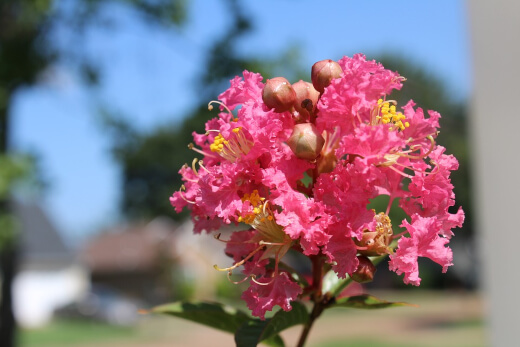
Crepe myrtles should be planted anywhere between late fall and early spring, allowing them enough time to establish themselves before the cold of winter. Some varieties may die back slightly during the winter, so it’s best to plant while it’s warm.
How to Plant Crepe Myrtle
Planting of your crepe myrtles is relatively straight-forward, and it doesn’t take them long to establish themselves. You may want to consider preparing your soil prior to planting with some well-composted manure or a balanced, quality compost.
To plant, simply:
- Dig a hole that is at least twice the size of the root ball. Ensure you loosen the soil to promote easier root growth.
- Centre the tree base and backfill with soil, watering as you go. The top of the root ball should rest slightly above the soil level. This will ensure the roots are receiving lots of oxygen.
- For larger varieties, you may want to stake after planting until the roots are properly established.
Mulching around the base is recommended to prevent the growth of weeds.
Propagating Crepe Myrtle
Cuttings can be taken from healthy crepe myrtle plants and should be done during the wintertime. To propagate, simply:


Get Your Free Guide:
Master Growing Australian Natives eBook
A Must Have Complete Guide for Every Australian Garden
Get Your Free Guide:
Master Growing Australian Natives eBook
A Must Have Complete Guide for Every Australian Garden
- Use a clean pair of gardening shears or loppers to remove a 10-15 cm hardwood cutting.
- Plant the cutting straight into a seeding mix.
- Keep your soil moist by watering regularly until rooted. Then, re-plant into the garden or a container.
How to Care of Crepe Myrtle
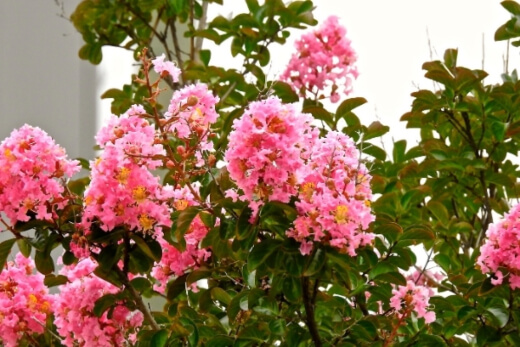
As with most tree types, your crepe myrtle will require occasional watering, light fertilisation and semi-regular pruning for optimal growth.
Watering Crepe Myrtles
Crepe Myrtles are drought-tolerant trees and will only need to be deeply watered once a week, twice if it’s a particularly hot or dry season. Even so, should you forget every now and then, it won’t be detrimental to your tree.
Lagerstroemia indica Fertilisation
In the spring and summer months, you can provide your crepe myrtle with a slow-release fertiliser as much as twice a month. In autumn and winter, cut back completely.
Crepe Myrtles do well with either an 8-8-8 or 10-10-10 fertiliser.
How to Prune Crepe Myrtle
Pruning is essential for most plant and tree health and will help you keep your desired form and size. Pruning should be carried out during the wintertime when your crepe myrtle is likely to die back slightly anyway.
Cutting back spent flowers will also assist in promoting second growth. Beware of over-pruning, also known as crepe myrtle murder. If over-pruned, it may put a strain on your crepe myrtle to focus all of its energy on stimulating new growth.
This will be at the expense of new blooms. Cutting back too much will also make your tree more susceptible to disease.
You can follow this handy pruning guide to help you.
Check out our best secateurs and pruning saws for your cutting needs.
What If You Don’t Prune Your Crepe Myrtle?
Unless you’re really regulating size and shape, you don’t have to prune your crepe myrtle. Not only will it bloom beautifully, but it has incredible bark and growth habits that make it a feature plant year-round, especially when not cut back drastically.
Pests, Problems & Diseases
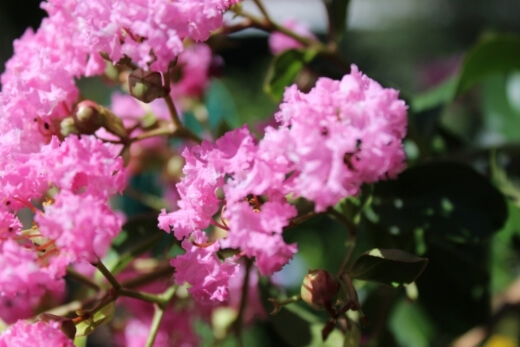
Although fairly tolerant to most issues, your crepe myrtle might be susceptible to fungal leaf spot or powdery mildew. These issues can easily be treated with an organic, horticultural spray. However, many modern cultivars are bred to be resistant to fungal disease.
Sometimes, you may also find scale insects or aphids that have infested your crepe myrtle. In these instances, be sure to treat your tree with insecticidal soap or neem oil.
Always ensure you treat the underside of the leaves, too, as these pests tend to hide there.
Crepe Myrtle Frequently Asked Questions
Can You Kill a Crepe Myrtle?
Any herbicides containing Glysophate used near your Crepe Myrtle will instantly kill it. So, unless you’re trying to get rid of an old stump, it’s not recommended for use.
How Do You Keep Your Crepe Myrtle Blooming?
It can take as long as two seasons before your crepe myrtle begins to bloom, so patience is essential with this species.
As mentioned, a lack of blooms can be due to over-pruning. However, it could also be a result of lack of sunlight. A Crepe Myrtle requires lots of direct sunlight to produce it’s blooms.
Should your tree be receiving plenty of sunshine and if you’ve been tentative with pruning, the lack of blooms could perhaps be related to over-watering or over-feeding.
Is Epsom Salt Good for Crepe Myrtle?
An Epsom salt solution is a great option to stimulate bloom growth. Mix a cocktail of one tablespoon of Epsom salt into 4 litres of water. Then pour around the base of your plant as part of your regular watering schedule.
Landscaping Tips for the Crepe Myrtle
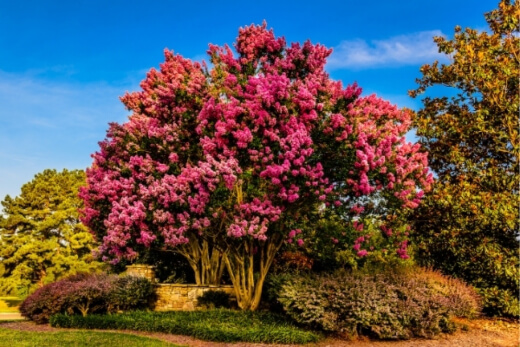
The many cultivars of Crepe Myrtle can be used in a variety of ways when it comes to landscaping and gardening. These include:
- Using it as a focal point in a garden.
- Using a multi-trunk variety to create a shaded canopy.
- Planting dwarf varieties for borders or in beds.
- Use medium-sized varieties as a deciduous hedge.
- Growing dwarf varieties to grow in containers.
Plus, as the Crepe Myrtle does not have invasive roots, they’re perfect for walkways and driveways and can be planted quite close to your home.
Many interchange crepe myrtle with lemon myrtle. To know the difference, check out our complete lemon myrtle growing guide.
Infuse Your Garden with the Timeless Elegance and Vibrant Hues of Crepe Myrtle
Wherever you decide to grow your Crepe Myrtle, you’ll be able to enjoy it’s beauty all year round. Keep up with semi-regular watering and feeding throughout the spring and summer months and feel free to cut back during the colder months.
For more flowers to add to you garden, be sure to check our Bromeliad and Chrysanthemum growing guides.
This fantastic flowering tree or shrub can be grown almost anywhere and will definitely provide that perfect garden feature you’re looking for. What are you waiting for? Start growing Crepe Myrtle now.
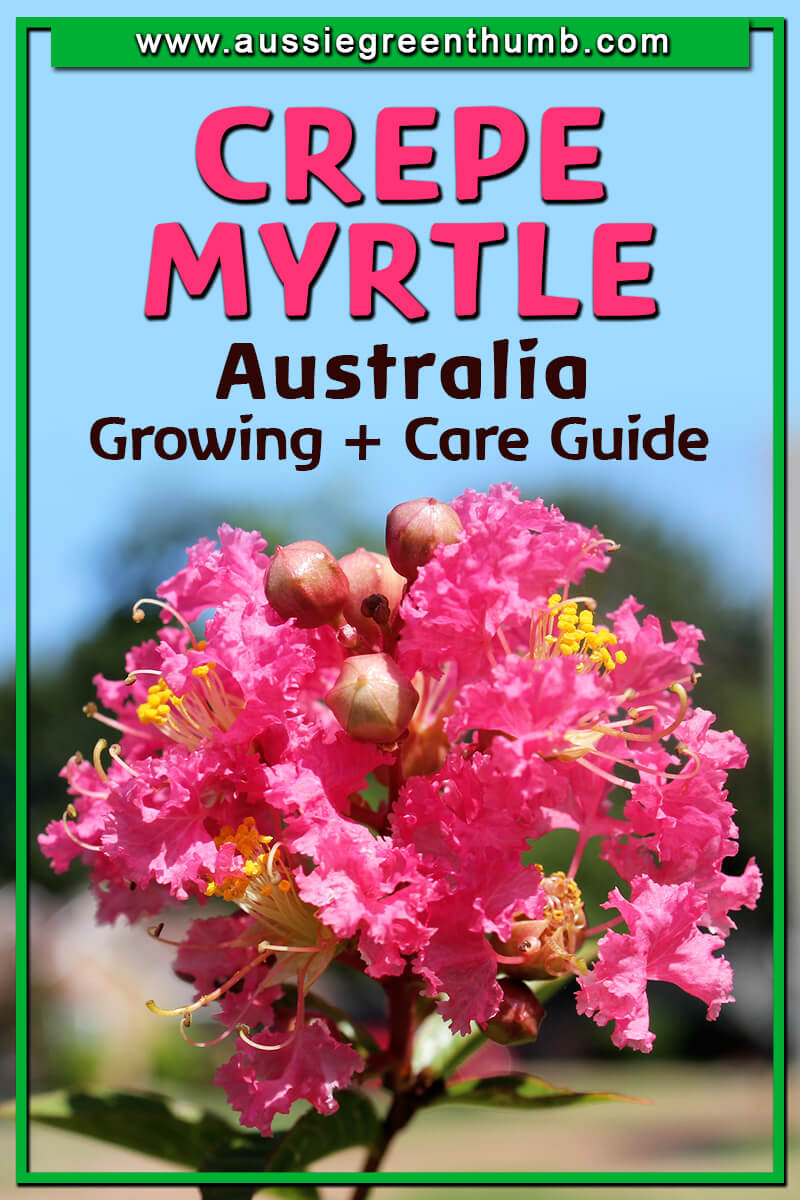
Published on September 14, 2021 by Gary Clarke
Last Updated on February 15, 2024





Crape myrtles are ubiquitous in the South, unsurprisingly thriving in hardiness zones 7 through 10. If you live in the warmer parts of the US, you may be able to enjoy this tree's colorful blooms as early as summer through fall. In short, the ideal months to grow this plant are from June to the end of September.